
In the Spanish language, greetings play a fundamental role in establishing connections and social interactions, whether in formal or informal settings. In Spanish-speaking countries, the way you address someone can depend on the situations and the relationship you have with the person.
In more formal situations, it is common to use greetings like “Buenos días” or “Buenas tardes” followed by a “¿Cómo está usted?” or “¿Cómo le va?” as a polite way to ask how the other person is doing. This is the most courteous way to ask “How are you?” in Spanish, especially in professional settings or with older individuals.
In everyday and informal contexts, it is more common to use expressions like “¿Qué tal estás?” or “¿Cómo estás?” to ask how someone is feeling. Other informal greetings include “¿Qué tal?”, “¿Qué pasa?”, or “¿Qué hay?”, which are more common among friends and in relaxed situations.
It is important to note that the response to these greetings may vary depending on the level of formality. Responses like “Estoy bien, gracias” or “Todo bien” are useful for both formal and informal situations. However, in a more casual context, responses may be more relaxed, such as “Muy bien, ¿y tú?” or even “Pura Vida” in some Latin American countries.
In this guide, you will know the difference between saying “How are you in Spanish?” in both formal setting and informal setting. Stick around until the end.
Formal Ways to Say “How Are You”

In Spanish-speaking cultures, formality plays a crucial role in greetings, especially in formal settings such as professional environments or when addressing someone of higher authority or respect. Formal greetings demonstrate courtesy, respect, and professionalism.
Here are some common ways to ask “How are you?” in formal settings:
- ¿Cómo está usted? – This is the most common and polite way to ask “How are you?” in a formal context. It’s appropriate when speaking to someone you don’t know well, elders, or in professional situations.
- ¿Cómo le va? – This expression is similar to “How are you doing?” in English. It’s polite and respectful, suitable for addressing someone formally, particularly in professional contexts.
- ¿Cómo se encuentra? – This is a formal way to inquire about someone’s well-being. It’s often used in professional or medical settings to show concern and respect.
- ¿Qué tal está? – This is another formal way to ask “How are you?” It’s polite and suitable for formal situations, especially when addressing someone you want to show respect towards.
- ¿Cómo se siente usted? – This phrase translates to “How are you feeling?” and is commonly used in formal settings, particularly when showing concern for someone’s well-being, such as in medical or professional contexts.
- ¿Cómo va todo por su parte? – This phrase translates to “How’s everything going on your end?” and is commonly used in formal settings, particularly in business or professional interactions, to inquire about the person’s current situation or progress.
These formal greetings are appropriate in a more formal setting, including:
- Business meetings and negotiations
- Interviews and job-related interactions
- Professional emails and correspondence
- Formal social events with people you don’t know well
- Interactions with elders or authority figures
- Conversations with clients or customers in a business setting
Using these formal greetings demonstrates your respect and professionalism in Spanish-speaking environments. It’s essential to understand when to use formal language to ensure appropriate communication in various social and professional contexts.
Below is a summary of the Spanish words to say “how are you” in Spanish language formally:
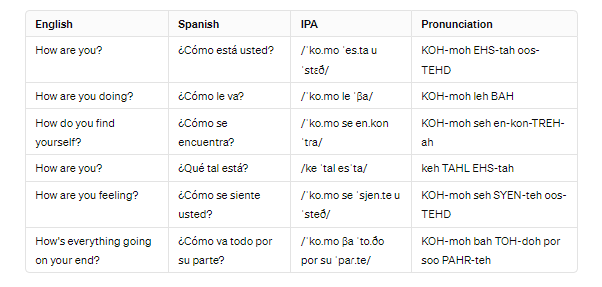
Informal Ways to Say “How Are You”

In Spanish, informal greetings reflect a sense of familiarity and casualness between individuals. These greetings are commonly used among friends, family members, and acquaintances in relaxed settings.
Here are some common ways to ask “How are you?” informally in Spanish:
- ¿Qué tal? – This is one of the most versatile and commonly used informal greetings in Spanish. It can be translated as “How’s it going?” or “What’s up?”
- ¿Cómo estás? – This is a straightforward way to ask “How are you?” among friends or peers.
- ¿Cómo te va? – This expression is similar to “¿Cómo estás?” but it has a slightly more informal tone, asking “How’s it going for you?”
- ¿Qué pasa? – Literally translating to “What’s happening?”, this greeting is commonly used among friends to ask how someone is doing or what’s going on in their life.
- ¿Qué hay? – This informal greeting can be translated as “What’s up?” or “What’s going on?”
- ¿Cómo andas? – This informal expression is similar to “How are you?” and is commonly used among friends or peers in casual settings.
- ¿Cómo te encuentras? – This phrase translates to “How do you find yourself?” and is used informally to inquire about someone’s well-being.
- ¿Cómo te sientes? – Literally meaning “How do you feel?”, this informal phrase is used to ask about someone’s emotional state in a friendly manner.
- ¿Qué tal estás? – Similar to “¿Cómo estás?”, this phrase is a casual way to ask “How are you?” among friends or acquaintances.
- ¿Qué me cuentas? – Translating to “What can you tell me?”, this informal greeting is commonly used to catch up with someone and see how they’ve been.
- ¿Qué onda? – This is a slang expression used among friends to ask “What’s up?” or “How’s it going?”
- ¿Qué haces? – Literally translates to “What are you doing?”, this informal greeting is often used to initiate a conversation and inquire about someone’s current activities or situation.
These informal greetings are appropriate for everyday conversations among friends, family, classmates, and colleagues in informal settings such as:
- Casual gatherings or meetups with friends
- Conversations with classmates or peers
- Interactions with acquaintances or neighbours
- Casual exchanges in social settings like parties or events
- Informal communication in everyday life situations
Using these informal greetings helps establish a friendly and relaxed atmosphere in conversations and reflects the informal nature of the relationship between the speakers.
Below is a list of the Spanish words to say how are you in Spanish informally:
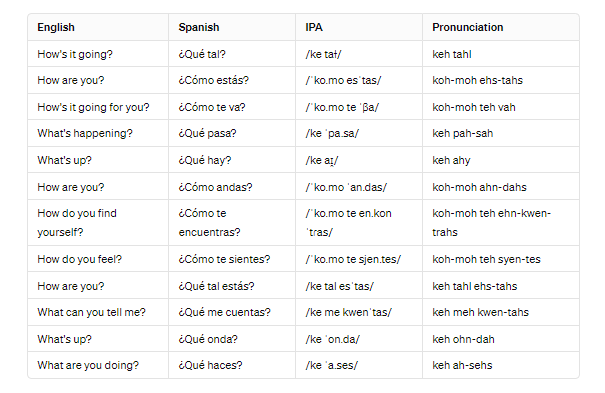
Moreover, here are some examples of saying how are you in Spanish slang:
- ¿Qué tal? – How’s it going?
- ¿Qué onda? – What’s up?
- ¿Cómo andas? – How are you doing?
- ¿Qué hay de nuevo? – What’s new?
- ¿Qué pasa? – What’s happening?
- ¿Qué hay? – What’s up?
- ¿Qué hubo? – What’s up?
- ¿Cómo va todo? – How’s everything going?
- ¿Qué cuentas? – What’s up?
- ¿Cómo estás tú? – How are you?
- ¿Cómo te ha ido? – How have you been?
- ¿Qué tal estás? – How are you doing?
- ¿Qué te cuentas? – What’s up?
- ¿Qué tal están ustedes? – How are you all?
- ¿Cómo estáis? – How are you all?
- ¿Cómo están? – How are you all?
- ¿Cómo te sientes? – How are you feeling?
- ¿Cómo va? – How’s it going?
- ¿Qué haces? – What are you up to?
- ¿Qué tal todo? – How’s everything?
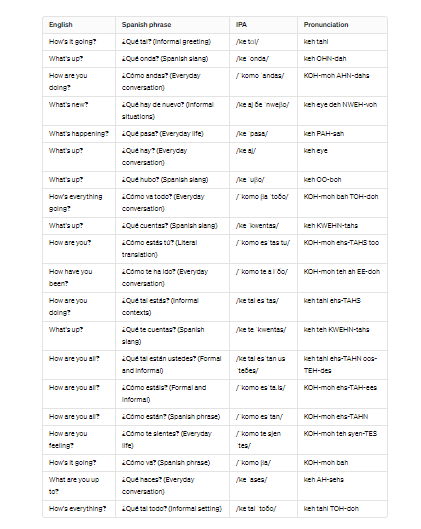
Responding to “How Are You” in Spanish

Responding to greetings in Spanish involves providing an appropriate and polite answer depends on the level of formality and the context of the conversation. In both formal and informal settings, it’s polite to reciprocate the question by asking “Y tú?” (And you?) or “¿Y usted?” (And you?) to show interest in the other person’s well-being. Additionally, expressing gratitude for asking, such as “gracias por preguntar” (thank you for asking), adds politeness to the response.
Formal Ways To Respond to How Are You
When responding to formal greetings in Spanish, it’s important to use a polite and respectful tone.
Here are some common appropriate responses for formal settings:
“Muy bien, gracias. ¿Y usted?” – Very well, thank you. And you?
This response acknowledges the inquiry into your well-being and reciprocates the question to show interest in the other person’s state.
“Estoy bien, gracias. ¿Y cómo está usted?” – I’m well, thank you. And how are you?
Similar to the first response, this one expresses gratitude for the concern and inquires about the other person’s condition in a respectful manner.
“Todo bien, gracias por preguntar.” – Everything is fine, thank you for asking.
This response conveys that everything is going smoothly and appreciates the courtesy of asking about your well-being.
“Muy bien, gracias. ¿Cómo va todo para usted?” – Very well, thank you. How’s everything going for you?
This response not only acknowledges your positive state but also shows interest in the other person’s situation, using a more formal tone.
“Bien, gracias. ¿Y cómo le va a usted?” – Fine, thank you. And how are things going for you?
This response acknowledges your well-being and respectfully inquires about the other person’s circumstances.
In formal settings, it’s important to respond with courtesy and respect, acknowledging the inquiry into your well-being and reciprocating the question to show genuine interest in the other person’s state. Expressing gratitude for asking (“gracias por preguntar”) adds politeness to the response.
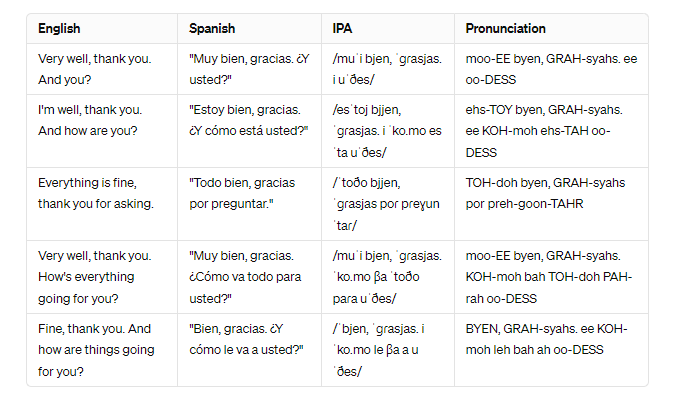
Informal Ways To Respond to How Are You
When responding to informal greetings in Spanish, it’s common to maintain a relaxed and friendly tone. Here are some common responses for informal settings:
“Bien, ¿y tú?” – Good, and you?
This response acknowledges that you are doing well and returns the question to show interest in the other person’s well-being.
“Estoy bien, ¿y tú qué tal?” – I’m good, and how about you?
This response indicates that you’re feeling fine and invites further conversation by asking the other person how they are.
“Todo bien, gracias por preguntar.” – Everything’s good, thanks for asking.
This response conveys that everything is going smoothly and appreciates the inquiry into your well-being.
“Muy bien, ¿y por allá?” – Very well, and over there?
This response indicates that you’re doing great and asks about the other person’s situation, using a more casual tone.
“Genial, ¿y contigo qué hay?” – Great, and what’s up with you?
This response expresses that you’re feeling fantastic and inquires about what’s going on with the other person, using a friendly and informal tone.
In informal settings, it’s typical to respond with a casual and friendly demeanour, acknowledging your well-being and showing genuine interest in the other person’s state. Inviting further conversation by asking “¿y tú?” (and you?) or “¿y por allá?” (and over there?) helps maintain the flow of the conversation.
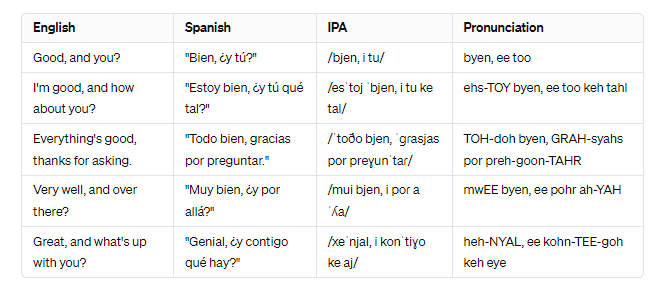
Regional Variations in Asking “How Are You” in Spanish
Cultural differences, historical factors, and linguistic evolution can influence regional variations in Spanish greetings. As a result, the way people ask “How are you?” may vary across different Spanish-speaking regions.
Here are some examples from various countries:
- “¿Cómo estás?” “How are you?” – Mexico
- “¿Qué tal estás?” “How are you doing?” – Spain
- “¿Qué onda?” “What’s up?” – Mexico
- “¿Cómo te va?” “How’s it going for you?” – Argentina
- “¿Qué cuentas?” “What’s new?” – Colombia
- “¿Cómo andas?” “How are you getting along?” – Spain
These examples demonstrate the diversity in greetings across Spanish-speaking countries, showcasing variations in both the wording and the informality of the expressions used. It’s important to be aware of these regional differences when communicating with Spanish speakers from different parts of the world.
Here is a list of more Spanish phrases, their literal translation and region:
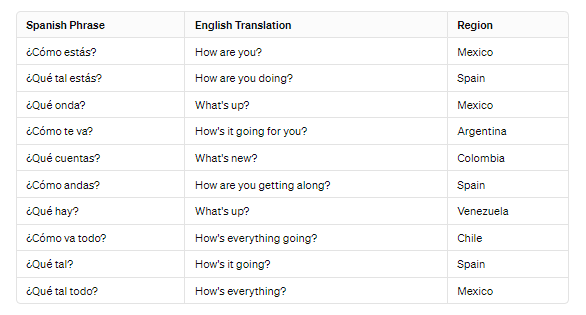
Tips for Mastering Spanish Greetings

To master Spanish greetings effectively, consider the following practical tips:
Practice Pronunciation: Focus on correctly pronouncing Spanish greetings to ensure clear communication. Listen to native speakers, use pronunciation guides, and practice speaking aloud to improve your pronunciation skills.
Understand Cultural Context: Learn about the cultural nuances surrounding Spanish greetings in different regions. Understanding when to use formal or informal greetings and the appropriate context for each can enhance your interactions with native speakers.
Recognize Formality Levels: Familiarize yourself with formal and informal forms of greetings in Spanish. Pay attention to the context and the relationship between speakers to determine the appropriate level of formality to use.
Expand Vocabulary: Expand your repertoire of greetings by learning additional phrases commonly used in Spanish-speaking countries. This includes informal greetings like “¿Qué tal?” and “¿Qué hay?” as well as formal greetings like “¿Cómo está usted?” and “¿Cómo le va?”
Immerse Yourself: Immerse yourself in the Spanish language and culture by practising greetings in real-life situations. Engage in conversations with native speakers, watch Spanish-language media, and explore cultural resources to reinforce your understanding of greetings in context.
Practice Regularly: Incorporate greetings into your daily language practice routine. Practice with flashcards, language apps, or language exchange partners to reinforce your knowledge and improve your fluency in using Spanish greetings.
By following these tips and actively incorporating Spanish greetings into your language-learning journey, you’ll build confidence and proficiency in greeting others in Spanish effectively.
Conclusion
In conclusion, greetings play a crucial role in Spanish culture, serving as the foundation for building relationships and establishing rapport. Understanding the importance of greetings in Spanish-speaking countries is essential for effective communication and cultural exchange.
Throughout this exploration, we’ve learned that there are various ways to ask “How are you?” in Spanish, with expressions ranging from formal to informal and varying across different regions. From the formal “¿Cómo está usted?” to the informal “¿Qué tal?” each greeting carries its own nuances and cultural context.
It’s important to recognize the significance of formality levels and regional variations when using Spanish greetings. By mastering pronunciation, understanding cultural context, and expanding vocabulary, learners can enhance their ability to greet others appropriately in Spanish.
Explore the rich diversity of Spanish greetings and practice using them in everyday interactions. Whether through language exchange partners, immersive experiences, or cultural resources, embracing Spanish greetings will not only improve language proficiency but also deepen cultural understanding and connection.
So, ¡adelante! (Go ahead!) Explore, practice, and enjoy the vibrant world of Spanish greetings. ¡Buena suerte! (Good luck!)
Ready to take your Spanish greetings to the next level? Immerse yourself in the language and culture with a comprehensive Spanish course in Singapore. We offer a variety of programs designed to boost your confidence and fluency in using Spanish greetings and communication in real-world scenarios!


Sorry, the comment form is closed at this time.